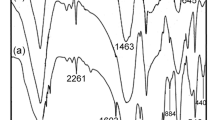Abstract
Thermally induced Kumada rearrangement of –Si–Si– linear chains in polysilanes to –Si–C– chain was conducted in the liquid–vapor phase, followed by isothermal treatments at 410, 460 °C and pressure of 15 kgf cm−2 leading to polycarbosilane(PCS) with higher silane (–Si–H) content in the range 0.46–0.58 mass%. Molecular and thermal changes during the oligomer to polymer transformation were investigated, applying spectral and thermal techniques. FTIR, Raman, and 1H, 13C, and 29Si-NMR analytical results established the chemical structural formula, –Si–Si–, –Si–C–, –Si–H bonding networks, and evolution of –Si–H functionality in as-synthesized polycarbosilane during the thermal transformations. FTIR and 29Si-NMR studies followed the increase in silane content (–Si–H). Raman data revealed the formation and disappearance of –Si–Si– functional group as the transformation progresses. Average molecular mass increased proportionally with polymerization reaction time. Thermogravimetric studies at 1400 °C confirmed a polymer to ceramic conversion (ceramic yield) of as-synthesized PCS increased with the increase in mass average molecular mass and found to be as high as 88% mass. The formation of a high purity green β-SiC powder on heat treatment at 1500 °C confirmed the high molecular polycarbosilane.

















Similar content being viewed by others
References
Octavio F, Rajendra KB, Daisy N, Walter K, Gunter M. Ceramic fibers based on SiC and SiCN systems: current research, development, and commercial status. Adv Eng Mater. 2014;16:621–36.
Miele P, Bernard S, Cornu D. Toury B recent developments in polymer-derived ceramic fibers (PDCFs): preparation, properties, and applications—a review. Soft Mater. 2007;4:249–86.
Emre Y, Mucahit S, Suat BB. Ceramic fibers. Fiber technology for fiber-reinforced composites. Cambridge: Woodhead Publishing; 2017.
Sakurai H. Development of organosilicon polymer. Tokyo: CMC Press; 1999.
Stone FG, Graham WA. Inorganic polymers. New York: Academic Press; 1962.
Ohnaka T. Industrial scale fabrication and application of polysilane, in development of organosilicon polymers. Tokyo: CMC; 1999.
Lackey WJ, Starr TL. Fiber-reinforced ceramic composites. Park Ridge: Noyes Publications; 1990. p. 439–44.
Kohyama A, Kotani M, Katoh Y, Nakayasu T, Sato M, Yamamura T, Okamura K. High-performance SiC/SiC composites by improved PIP processing with new precursor polymers. J Nucl Mater. 2000;283:565–9.
Cheng X, Xie Z, Song Y, Xiao J, Wang Y. Structure and properties of polycarbosilane synthesized from polydimethylsilane under high pressure. J Appl Polym Sci. 2006;99:1188–94.
Kim Y, Geun Shin D, Kim HR, Han DY, Kang Y, Riu DH. Kumada rearrangement of polydimethylsilane using a catalytic process. Key Eng Mater. 2006;317:85–8.
Chen J, He G, Liao Z, Zeng B, Ye J, Chen L, Xia H, Zhang L. Control of structure formation of polycarbosilane synthesized from polydimethylsilane by Kumada rearrangement. J Appl Polym Sci. 2008;108:3114–21.
Ishikawa T, Kajii S, Matsunaga K, Hogami T, Kohtoku Y, Nagasawa T. A tough, thermally conductive silicon carbide composite with high strength up to 1600 °C in air. Science. 1998;282:1295–7.
Ishikawa T, Kohtoku Y, Kumagawa K, Yamamura T, Nagasawa T. High-strength alkali-resistant sintered SiC fiber stable to 2,200 °C. Nature. 1998;391:773–8.
Yajima S, Hasegawa Y, Okamura K, Matsuzawa T. Development of high tensile strength silicon carbide fiber using an organosilicon polymer precursor. Nature. 1978;15:525–7.
Birot M, Pillot JP, Dunogues J. Comprehensive chemistry of polycarbosilanes, polysilazanes, and polycarbosilazanes as precursors of ceramics. J Chem Rev. 1995;95:1443–77.
Lach C, Müller P, Frey H, Mülhaupt R. Hyperbranched polycarbosilane macromonomers bearing oxazoline functionalities. Macromol Rapid Commun. 1997;18:253–60.
Colombo P, Mera G, Riedel R, Sorarù GD. Polymer-derived ceramics: 40 years of research and innovation in advanced ceramics. J Am Ceram Soc. 2010;93:1805–12.
Fritz G. Carbosilanes. Angew Chem Int Ed Engl. 1987;26:1111–32.
Ishimoto K. Kinken monogatari-SiC Fiber, IMR news, vol. 61. Japan: Tohouku University; 2010. p. 9.
Fritz G. Formation and properties of carbosilanes. Angew Chem Int Ed Engl. 1967;6:677–83.
Fritz G, Grobe J, Kummer D. Carbosilanes. Adv. Inorg Chem. 1965;7:349–418.
Yajima S. Japanese patent. H54-061299; 1977.
Hong J, Cho KY, Shin DG, Kim SH, Riu DH. Structural evolution of SiC phase from polycarbosilane cured with iodine: NMR study. J Inorg Organomet Polym. 2018;28:2221–30.
Ichikawa H. Polymer derived ceramics. Annu Rev Mater Res. 2016;46:335–56.
Kim YH. United States patent no. US2009-0318655; 2009.
Nguyen CN, Hong LY, Kim DY, Lee JY, Woo HG. Facile synthetic route of polycarbosilane as a SiC precursor with zeolite catalysts. J Ceram Soc Jpn. 2006;114:487–91.
Riu DH, Kim YH, Shin DG, Kim HR. Characterization of SiC fiber derived from polycarbosilane. Ceram Trans. 2004;154:77–86.
Yajima S. Japanese patent, S57-026527; 1982.
Shin DG, Riu DH, Kim HR, Kim Y, Jeong YK, Park HS, Kim HE. Fabrication of silicon carbide fiber and non-woven fabric from the polycarbosilane produced using a catalytic process. Key Eng Mater. 2005;287:91–5.
Wang G, Song Y. Enhancing the yield of polycarbosilane synthesis via recycling of liquid by-product at atmospheric pressure. Ceram Int. 2018;44:6474–8.
Xue F, Zhou K, Wu N, Luo H, Wang X, Zhou X, Yan Z, Abrahams I, Zhang D. Porous SiC ceramics with dendritic pore structures by freeze casting from cross-linked chemical polycarbosilane. Ceram Int. 2018;44:6293–9.
Ji P, Pei X, Miao Y, He L, Huang Q. Effect of ultraviolet irradiation on the cross-linking process and ceramic yield of liquid hyperbranched polycarbosilane. Adv Appl Ceram. 2017;116:445–51.
Acknowledgements
This work was supported as part of an in-house R&D program on ceramic polymer development under Grant No. M-8-109. Authors thank Director, CSIR-National Aerospace Laboratories, Head, and Dy. Head, Materials Science Division, CSIR-NAL, for their constant encouragement and support to complete the program. Authors are also thankful to Prof. Stephen Podzimek, University of Pardubice, the Czech Republic, for carrying out the molecular mass measurements.
Author information
Authors and Affiliations
Corresponding author
Additional information
Publisher's Note
Springer Nature remains neutral with regard to jurisdictional claims in published maps and institutional affiliations.
Rights and permissions
About this article
Cite this article
Krishnan, G.S., Naveen, S. & Shahnawaz, M. Thermal rearrangements during liquid–vapor phase pyrolysis polycondensation of polysilane to high-functional polycarbosilane: spectral and thermal studies. J Therm Anal Calorim 147, 1251–1264 (2022). https://doi.org/10.1007/s10973-020-10459-7
Received:
Accepted:
Published:
Issue Date:
DOI: https://doi.org/10.1007/s10973-020-10459-7




